Raising quail is a popular choice for homesteaders who want to source their own meat and eggs in limited space. Quail are small, low-maintenance birds that don’t take up much room. Some quail can be raised for hunting purposes, either for sport or to train hunting dogs.
Different breeds of quail should be considered depending on your needs. For a homesteader, there are a few breeds that are suitable for meat and egg production. Others are purely ornamental, providing not much more than entertainment as pets. Since each breed offers different things, let’s find out which one is right for you.
The 7 Best Quail Breeds to Raise
1. Blue-Scale Quail
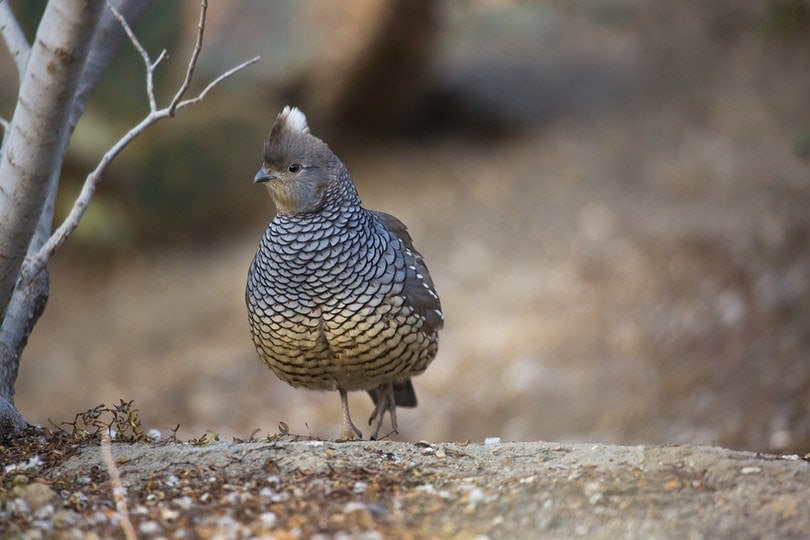
These highly social birds are also known as “Cotton Tops.” Blue-Scale quail is a rare breed. They produce eggs but can also be used for hunting purposes. They are calm and gentle birds with unique plumage on the tops of their heads. They’re skittish by nature and run away when they sense danger. For this reason, some people prefer not to raise this breed, even though they’re efficient egg-layers. They have blue to greyish-blue plumage, and the females have light pinstripes around their chins. A Blue-Scale hen can lay 50–60 eggs per year.
2. King Quail
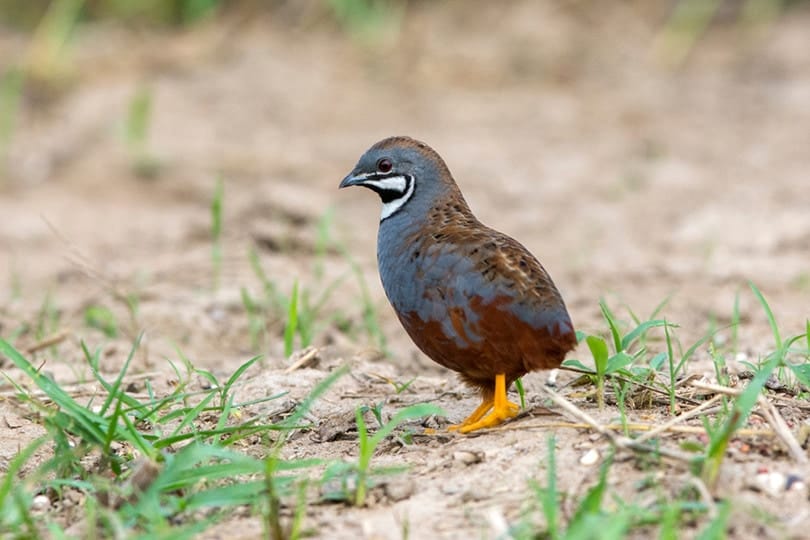
King quail are raised for both meat and eggs, but they are small birds. They are only 4–5 inches in length when fully mature. Frequent egg laying can stress the hens and may shorten their lifespan.
They are colorful birds that are kept as pets and for ornamental purposes. They will lay 6–8 small eggs at a time. They are also known as Chinese Blue quail and Painted quail. They prefer warm climates and should be kept with others of the same breed. One male and two females will be happy together. Two males together may be aggressive toward each other.
3. Coturnix Quail
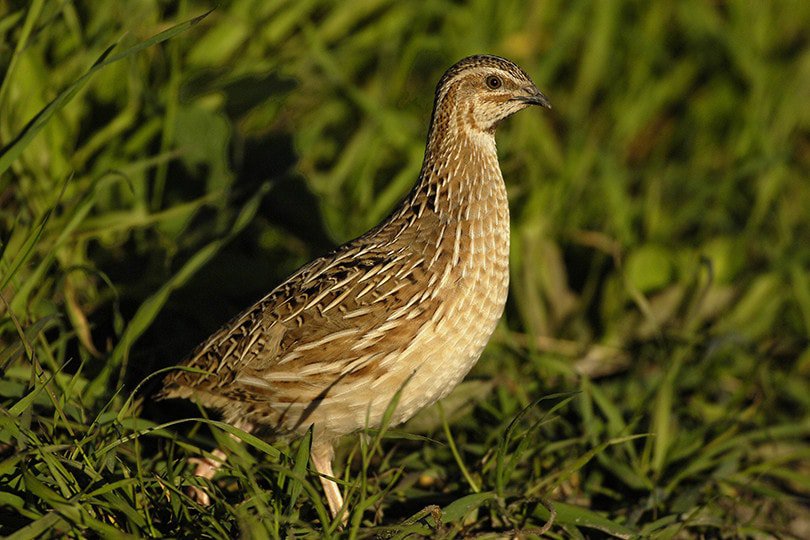
The Coturnix Quail can be used for egg-laying, meat, and hunting. They are hardy birds that will enable you to produce a profit. The hens can lay up to 200 eggs per year. They’ve been raised in captivity for hundreds of years and come in different varieties:
- Japanese quail
- Jumbo Coturnix, a dark-meat bird that can reach up to 16 ounces in weight
- Pharoah Coturnix
- English White, a pure light-meat bird
- Tibetan, the type of quail most often served in restaurants
- Tuxedo, a colorful cross between the Texas A&M and Tibetan
- Texas A&M, an all-light meat bird that can reach up to 13 ounces
- Rosetta, an all-black variety of quail
Coturnix quail require little space and are the easiest to raise. They’re solitary, calm birds that mature in about 7 weeks. Then, they’ll be ready to start laying eggs. If you’re breeding these birds, one rooster for every three to seven hens is the ideal grouping. If you’re just looking for eggs, hens without males will produce better-quality eggs. These quail require minimum interaction and have easy-going temperaments, so they are popular choices for first-time homesteaders.
4. Bobwhite Quail
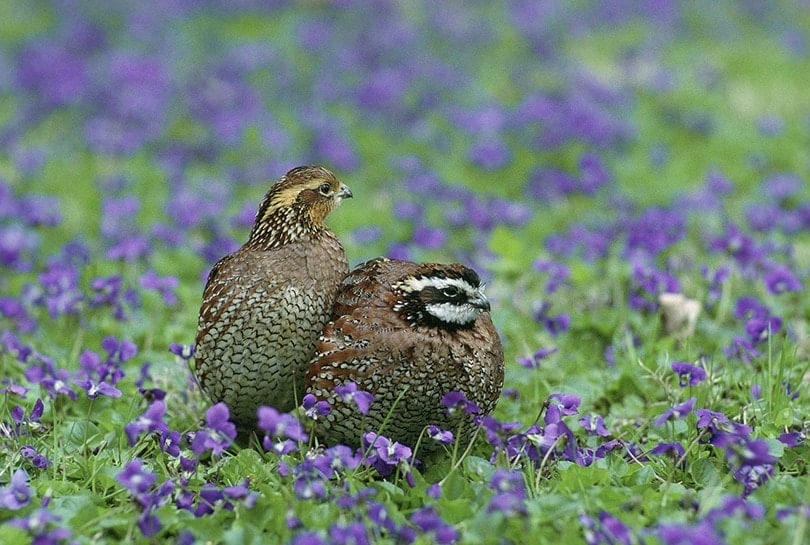
Though most popular for hunting purposes, Bobwhite quail can also be used for meat and eggs. They are beautifully colored in black, brown, and yellow. Males have white patches on their throats. Bobwhite quail are happiest when kept in pairs. Depending on their purpose, the birds must be raised in different conditions. Short cages that don’t allow enough room for flight are common when the birds are being raised for meat. If used for hunting, flight pens are used so the birds get used to flying and can be released for sport. Sometimes it’s possible to train the birds to come back after releasing them. They are usually harvested for meat between 14 and 16 weeks old.
5. Gambel Quail

These flighty birds can be difficult to keep because they like to escape their enclosures. They demand more care than other breeds. They are a favorite to raise because of their looks, though. Gambel Quail are patterned with grey, cream, and brown, with black comma-shaped plumes on their heads. They can be difficult to raise because their chicks learn to eat at a slow pace. Parents feed their young much longer than other breeds have to. These birds don’t produce many eggs each year but can still be used for egg production. Their primary uses are hunting and ornamental.
6. Mearns Quail
Also called Montezuma quail, this is a rare quail breed that is typically used for hunting. Most of these birds don’t live past 1 year in the wild, making them harder to locate than other breeds. In captivity, they can be difficult to raise and aren’t recommended for first-time homesteaders. They require much more space than other quail and need plenty of grass to build their nests.
7. California Quail
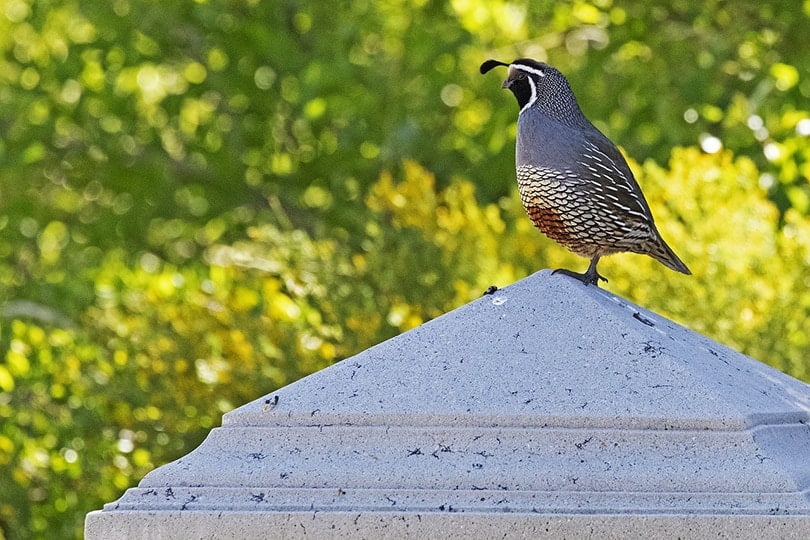
This breed is similar in appearance to the Gambel quail. It’s the state bird of California. In the correct conditions, California quail can lay eggs year-round. In addition to egg production, these birds are kept for entertainment and as ornamental pets.
Where to Purchase Quail?
You can purchase a starter stock of quail from breeders or hatcheries. It’s important to seek out healthy birds. Visit them first if possible, or find a breeder with a strong reputation for producing quality birds. Breeding unhealthy birds will result in unhealthy offspring for years to come.
Quail Housing
When quail are raised for hunting, they should be kept in a flight pen far away from humans. The goal is to teach the birds to foster their natural flight instincts while not becoming too familiar with people. Otherwise, once released, the birds won’t travel far and may even fly back to humans for food. This makes them undesirable as far as hunting goes.
Their enclosures should give the quail ample room to fly, learn to forage, and gain strength. When feeding the birds, humans should not interact with them.
When quail are raised for meat or eggs, they can be kept in smaller enclosures. This prevents them from being too active and depleting their muscle mass.
Since quail spend most of their time on the ground, it’s important to keep the floors of their enclosures clean.
Are Quail Worth Raising?
Quail are used for multiple purposes. They produce high-quality meat and eggs and are used for hunting purposes. Their manageable sizes make them ideal for those without much space. Some people find them easier to raise than chickens. Quail also mature faster than chickens and start laying eggs earlier.
In addition to what quail can provide in terms of production, they also make beautiful, gentle pets. They aren’t loud, so they won’t disturb your neighbors. With enough patience and persistence, some breeds of quail can become tame. They’re friendly and easy to care for and make colorful additions to aviaries.
People find quail to be worth raising because of benefits like the ability to have more birds per square foot of space, their ease of care, and having sustainable meat and egg sources.

How Many Quail to Raise
Large flocks are possible with quail because five birds take up the space of a single chicken. These are social birds that prefer to have company. It’s important to not have too many males, though, as this can lead to fighting and competition in small spaces. One male per every three to four females is ideal. It’s always better to have more females than males, even if this ratio isn’t exact. If you don’t wish to breed your quail, just keeping the hens for egg production without a male is possible.
Before You Decide to Raise Quail
While there are many great reasons to keep quail, there are also a few negatives to consider.
While they produce eggs and meat, they do so in smaller quantities than chickens, turkeys, or ducks. They’re smaller birds, so you’ll need more of them to meet your needs.
Quail start laying eggs quicker than chickens do, but their lifespans are only around 2 years. This means older quail will have to be replaced frequently to continue to keep up with the egg demand.
Quail are also attractive prey due to their small size. Extra consideration must go into their coops and housing to prevent predators from being able to reach them.


Final Thoughts
Quail are beautiful, low-maintenance birds that are easy to raise for eggs, meat, and hunting and as pets. No matter what your goal is, choosing to raise quail can be economical and fun. People often choose quail based on their coloring and patterns. They’re beautiful birds that make attractive additions to any backyard coop.
Featured Image Credit: Nel_Botha-NZ, Pixabay
